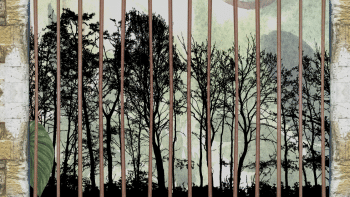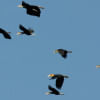Our cities need animals

"I have a surprise for you!" – I think I was four or five that morning when I was trying to: rub the morning sleep out of my eyes, and figure out what surprise Ammu had for me under the blanket. I was ready to put an end to my curiosity right then and there. But Ammu said hush, and not to wake him up. The big reveal came with a story – there came a kitten in our kitchen. He came down the window to have some rice. But he was so small, and his belly so full, that he tried and tried but couldn't get out. So, he was going to live with us.
It was through him, I think, that I started to truly grasp the concept of the "self" – that you don't have to talk, dress or look like us to deserve care and affection. You can be even more of an "other" than our house-help Khala's son and still not be timid about demanding food, attention or distance. No amount of moral lessons, criticisms or "Ah! Dushtumi kore na loke ki bolbe?" could manipulate him. The only way to come to terms with his Nawabi self was with careful interaction. He didn't have the slightest care about our family hierarchy, or the concrete walls that restricted us. He would go out at his will and only return if you offered a liveable place. And there he was, a curled-up thief sleeping on my mother's lap – an object of jealousy (why wasn't it me the one sleeping there?!) and fascination; and a free individual where I can proejct my "self" and pretend to explore reality from different perspectives. I wonder, when we complete our endeavours of cleansing our urban space from animals, how will it affect us and our society?
Gene Myers, in his book The Significance of Children and Animals, explores this idea, and concludes – in a social environment deprived of non-humans "there would be no rich sense of different interactive styles, no quasi-social domain free of pressures and deceptions of the human realm. There would also be a sense of isolation rather than of being in the company of other creatures who confirm one's sense of going-on-being, agency, affectivity, coherence, and history; fewer perceptions of other ways of being, of seeing oneself-as, and of pretending to be in alternative concrete and subjective realities." It's even hypothesised that mechanisms that are at work when inhumanities are perpetrated – moral conditioning, euphemisms, victim blaming, dehumanisation, and denial of personal responsibility – are also present in animal exploitation. Basically, lack of exposure to animals can make individuals and society more immature, intolerant, and inhuman.
Maybe we humans can somehow survive living in the most unliveable place in the world, but animals can't. Our policymakers are oblivious to the layers of life inside the forests and under the rivers. They don't seem to notice the greens declining and rivers dying until someone points out that a species has gone extinct. Isn't it surprising that we've somehow become more ruthless in colonising our nature than the British, and turned one of the most fertile and biodiverse patches of land in the world into an ecologically dead city?
When I was growing up in Tongi, it still had some wildlife left. We didn't hear jackals howling at night like the stories our elders told us, but in the pond behind our home, I used to see snakes coiling around fish, in an attempt to eat them. I'd get mixed feelings – a sense of excitement for the snake and a lump in my throat for the fish. After asking around, I eventually learned that this is just nature. I'd see birds of all kinds sitting on my veranda, snails scaling the walls, goats running around, and sometimes even monitor lizards. But within just 15-20 years, that place has lost almost all of its biodiversity. Our "development" has detached my niece's sense of reality from the stories of her grandparents, along with our fables, poems, songs, philosophy, and cultural legacy. This is not just the story of Tongi but the countless places in Dhaka that have died within decades.
The core problem is that we have placed development against conservation, civilisation against nature, and separated humans from natural environments. In urban Western philosophy, which we try to blindly copy, this segregation perhaps took root when Descartes started considering animals as non-living objects. In our part of the world, although our Central Asian conquerors initiated the reduction of animals into objects, it was the British colonisers who brought their capitalist worldview and started the wildlife genocide.
Just like us non-Caucasian humans, nature was also just an infinite source of profit for them. Vast forestlands were cut down for wood, and the cleared grounds were used for agricultural spoils. The East India Company disregarded native traditions of replantation and cohabitation. The colonisers persecuted entire communities when there were protests. After the crown took over, they created forest departments and conservation laws – not because they cared for nature, but because their once seemingly infinite source was extorted to near extinction. For them, native animals served three purposes: tools you can control (elephants and cows); games that you hunt for food and sport; and beasts that you must kill as a Sahib saviour. Tigers were hunted down to such an extent that the Raj had to make protected areas to try and keep some for the European customers travelling for a fun week of hunting.
Unfortunately, like many other things, we inherited this culture from our oppressors. Deforestation and destruction of biodiversity continued and even escalated after our independence. We are creating roads and railroads that cut through habitats, industries that poison water, construction works that make the air toxic, and "development" that excludes animals. Maybe we humans can somehow survive living in the most unliveable place in the world, but animals can't. Our policymakers are oblivious to the layers of life inside the forests and under the rivers. They don't seem to notice the greens declining and rivers dying until someone points out that a species has gone extinct. Isn't it surprising that we've somehow become more ruthless in colonising our nature than the British, and turned one of the most fertile and biodiverse patches of land in the world into an ecologically dead city?
If we really want to move away from this path of destruction, we need to ensure environments where wildlife and humans can harmoniously coexist. We have to focus on places like Dhaka, where wildlife has been completely uprooted; new cities or city extensions, where relatively conserved areas will eventually be urbanised; and rural areas, where village and (toxic) city life are melding. But first and foremost, we must include biodiversity as an essential part of development. It has to be incorporated into our policies, city regulations, and urban designs. For instance, it's commendable that there are certain percentages of green patches reserved in the designs of the new economic zones and city extensions. But that is nowhere near what is required. None of the designs addresses how the establishments will affect migration, food sources, life cycles of different species, or how the city interacts with wildlife. And what about when a city needs to expand further? Will it just "save" another small percentage of green and conquer the rest? When you put "development" against nature, it's always "development" that wins.
There's a German development company that is advocating the philosophy of "animal-aided design" – using which urban planners incorporate biodiversity as a foundational block, not a late addition that designers have to somehow manage, making compromises. If we, the people who barely raise such issues, adopt a similar policy, it will make us take a hard look at our geography, weather, biodiversity, and society. We can even study native traditions, get inspired by "Aranya Sanskriti," a social order that revolves around forests, from the Maurya and Gupta empires, or come up with a new design philosophy of our own.
I know it sounds bizarre to hope for a human-nature utopia in this country, given the track record. But this delta is now once again at the crossroads of becoming an economic powerhouse. This is the time to decide what path we will take in our journey towards a developed nation. And even if we fail to make proper implementations, the mere acceptance of cohabitation in our policy can push our environmental standards higher. Animals are great environmental health indicators, even for the aspects we don't usually consider to be important, like sound or light pollution. During Covid, we've seen how mere days of non-interference brought back dolphins to our coast. Why can't I hope to see dolphins in our rivers like my father used to on his way to Bhola? Maybe places like Dhaka can never bring back many that are already lost, but if we invest in reparation for all the wrongs we've done – maybe there's a chance squirrels, owls, and monkeys will come out of the last remaining sanctuaries in the city.
We must realise we can't afford the audacity to exclude ourselves from the ecosystem. We need animals to have a liveable environment, even in the artificial worlds we create.
Naimul Alam Alvi is a member of the editorial team at The Daily Star.
Views expressed in this article are the author's own.
Follow The Daily Star Opinion on Facebook for the latest opinions, commentaries and analyses by experts and professionals. To contribute your article or letter to The Daily Star Opinion, see our guidelines for submission.

 For all latest news, follow The Daily Star's Google News channel.
For all latest news, follow The Daily Star's Google News channel. 










Comments